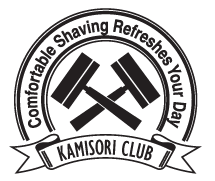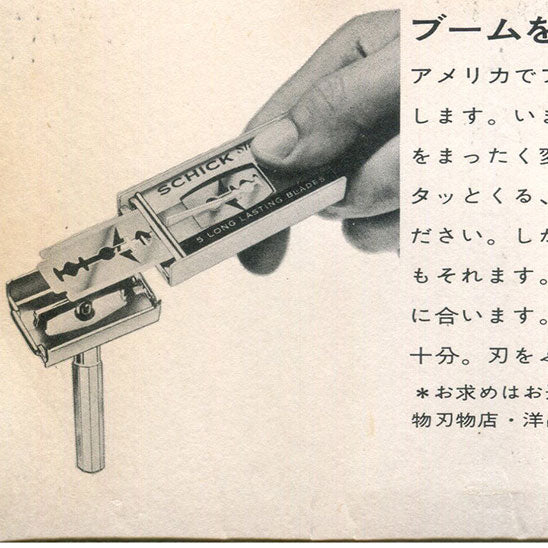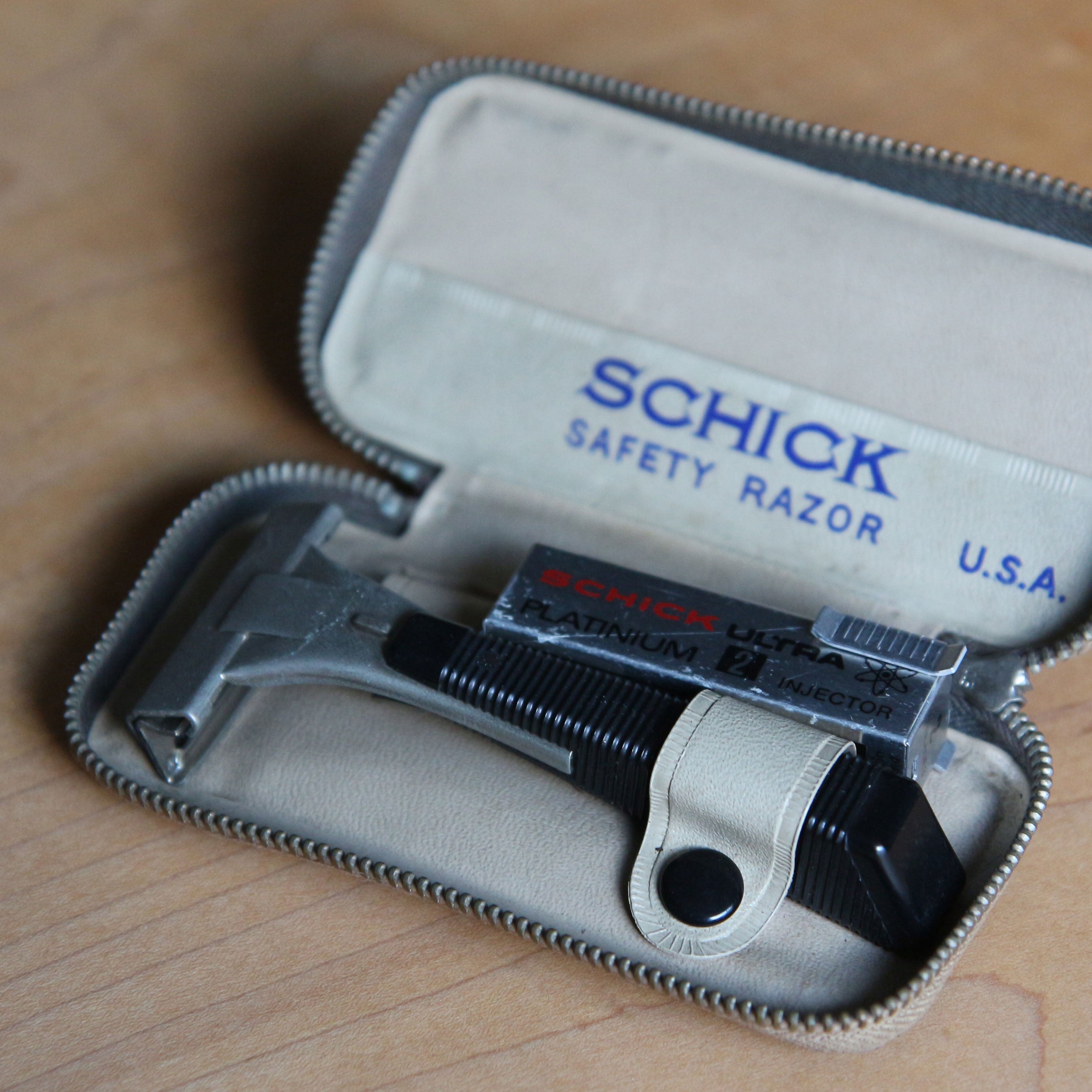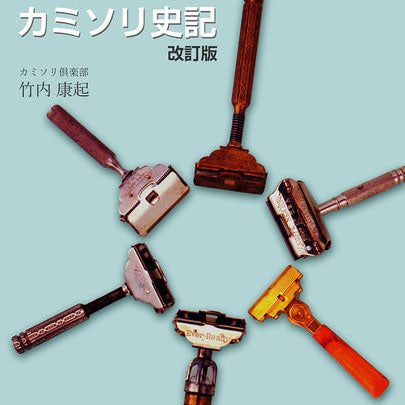
History and Culture of Shaving in Japan


This book is written by Mr.Yasuoki TAKEUCHI, President of Sanpo Shoji K.K. ( Sanpo Trading Co., Ltd.) one of the leading distributors of shaving razors and household cutlery. Almost 30 years have passed since he joined the company as a salesman for razors and blades. Naturally he has taken a keen interest in collecting antique razors and increasing his knowledge of shaving, tools and techniques. Sanpo Shoji celebrates its 55th Anniversary this year, thus he thought it is an opportune time to write a book compiling his experiences during the past years.
In his busy daily life he would sometimes wonder when the custom of shaving beards began, which directed him to look into the origins of shaving. Therefore in Chapter 1 he gives us a cultural and historical explanation on the development of shaving tools and techniques through the ages.
It is interesting to know that the origin of shaving goes back to the Paleolithic Age (about 20,000 years ago). When ancient tombs were excavated relics such as shells with pointed edges, broken pieces of volcanic glass and shark’s teeth were found, these are considered to have been used as shaving implements. In the Bronze Age (about 3,500 years ago) the prototype of a razor had already been made in Egypt. In the Medieval Ages growing a beard became fashionable in England.
The Japanese like to grow beards. The Kamisori (razor) came to Japan from China with the introduction of Buddhism in the Asuka Era (552-645). It was a sacred tonsuring tool used by Buddhists.
Razors were improved significantly in the 19th Century. Although quite a few attempts had been made to develop a razor that was safe, this was finally accomplished in 1904 by Mr. King C, Gillette with the help of Mr. William Nickerson, a professor at Massachusetts Institute of Technology. Initially the razor achieved worldwide expansion when it was designated as a war supply and the United States government procured 3.5 million razors and 36 million spare blades. Thus Gillette safety razors were taken abroad to many foreign countries by American military personnel. Then in 1921 Mr. Jacob Schick, veteran Colonel of the United States Army invented the single-edge injector safety razor. In 1931 he also invented razors driven by small electronic motors, these are considered to be the forerunner of the present electric shavers.
In 1952 there was a remarkable innovation in the material for razor blades. Until then, all razor blades had been made with carbon steel, but these carbon steel blades were soon replaced with the introduction of stainless steel blades. The stainless steel material for manufacturing razor blades is now produced in Japan by Hitachi Metal Company. Their stainless steel hoops are supplied to major razor manufactures worldwide. The book tells us how Hitachi’s Yasugi steel is made and processed into steel hoops ready for razor blade production.
Chapter 1 closes with an explanation of why the Kamisori Club, shaving Culture Centre was opened in 1989.
Chapter 2 gives us a more detailed explanation of the razor market developments in Japan. During the MEIJI ERA ( 1868 – 1912 ) mainly open razors were used. However, in the latter part of the MEIJI ERA foreign made razors came into Japan with the introduction of western civilization. Some from Solingen in Germany and others from Sheffield in England. After World War1 (1914 – 1918 ) Gillette T-Shape safety razors were imported and they gradually replaced the open razors. Two Germany POWs staying in Japan began making safety razors, and were succeeded by Nihon Anzen Kamisori Kyogyo K.K. ( Japan Safety Razor Industries, later changed to Feather Anzen Kamisori K.K.- Feather Safety Razor Company).
The onset of the China incident in 1937 led Japan to war in the Pacific and World War 2. In 1940 the Japanese government banned not only the import of razors but also the production of open razors. However the production of safety razors was excluded from this ban. Therefore Feather was able to monopolize the market and their market share reached 80%.
Following the end of the war when the Japanese economy was recovering quite rapidly the Japanese government lifted the ban of the import of razors. The import of spare blades was liberalized 2 year later and foreign razor manufactures simultaneously entered the Japanese market. Eversharp Schick appointed Hattori as their import agent and Hattori appointed Sanpo as there sales agent. Before the war Gillette had been represented by Muller Phips and Sellers. Valet in England had been replaced by Muller or Maruzen as their import agent. Sanpo assisted Maruzen in getting the agency by offering them “ yusen gaika” ( a kind of import license) which could only be obtained at a premium. Maruzen succeeded in becoming the import agent and Sanpo became the sales agent for Gillette in addition to Schick and Feather. Schick had introduced their single- edge injector razors as a prestigious gift item, which sold very well.
In 1964 Wilkinson changed their import agents from Dodwell to Lion. Then in 1969 American Safety Razor was represented by Kao. Competition among domestic and foreign manufactures was accelerated. During the period of 1965- 1970 Schick increased their market share from 4.7% to 25%. On the other hand share of Gillette and Feather dropped from 9.4% to 8.1% and from 72.7% to 42.7% respectively.
There are several reasons that account for Schick’s increased sales. Schick aggressively expanded the sales outlets by conferring with Hattori and Sanpo. They introduced their stainless steel blades one step ahead of other manufacturers. They also invested a substantial amount of money to carry out a large scale campaign.
Gillette failed to increase their sales because they were putting too much confidence in sales of their double-edge T-shape razors and carbon steel blades. They also expanded their distribution system by increasing the number of wholesalers to 150 which disappointed some of their existing wholesalers. Feather had been enjoying a successful business and failed to foresee the new market trends.
The 5 years from 1971 to 1975 could be termed as the “ First Stage of Shape Competition ”. In the meantime Eversharp Schick had been merged into Warner- Lambert, nevertheless they did not change the distribution network firmly set up by Hattori and Sanpo. In 1971 Gillette tried to recover market share by introducing their twin-blade GⅡ razor. Schick were also introducing their twin-blades SⅡ razor. Thus the Warner-Lambert Tokyo office took every GⅡ, and succeeded. During this period sales for both Feather and Wilkinson dropped due to the decreasing demand for both double-edge T-shape razors. Only Schick market share increased from 37.6% to 59.17%.
The 5 years from 1976 to 1980 could be termed as the “ Second Stage of Share Competition”. During this period the Schick market share continued to increase from 63.6% to 69.8%. On the other hand the market share for Gillette, Feather and Wilkinson dropped by more or less 2%. In fact Schick surpassed other manufacturers in every category. The market remained quite until 1975 when BIC in France entered with their disposable razors. This re-activated the market. In 1990 Gillette introduced their new twin-blade “ Sensor” razor, an innovation of highly sophisticated technology. Then in 1991 Schick introduced the equally innovative “FX” razor. No-one can predict who will be next in the market with a new razor.
ChapterⅢ explains the history of Sanpo Shoji K.K. starting with the success of Mr.Kinzo TAKEUCHI who began his career as a clerk in a silk exporting company in YOKOHAMA. It was in the midst of the World Depression that had started in 1925. Silk had been one of the staple products of Japan, but new artificial fibers such as rayon and nylon that had been invented.
In 1932 he joined a wholesale company where he first took a business interest in razors. In 1939, at the age of 25, he started his own company, TAKEUCHI Shoji K.K., but could not continue due to the entering of Japan into World War 2 and the subsequent ban by the Japanese government on the import and production of razors.
After the war, in 1945, he re-started TAKEUCHI Shoji K.K., which , in 1949 he reorganized and changed the name to Sanpo Shoji K.K. to cope with the expanding business. In that same year Sanpo Shoji was appointed as the sales agent for Feather Safety Razor Company.
When the import ban was lifted in 1960 for razor holders, and in 1962, for the spare blades, foreign manufacturers approached the Japanese market. Eversharp Schick appointed Hattori Tokeiten ( now Hattori Seiko) as their import agent. Gillette authorized their agency to Maruzen. The agency for ASR ( American Safety Razor) was given to Kao and that of Wilkinson to Lion. At this time a yusen gaika( import license) was necessary in order to import merchandise. Mr.Takeuchi closely cooperated with Hattori and Maruzen and offered them the yussen gaika that he had obtained at a costly premium. This enabled Sanpo to become the sales agent for both Schick and Gillette in addition to Feather.
Mr. Kinzo Takeuchi’s enthusiasm and sincerity won the confidence of both suppliers and customers and that was the main reason why Sanpo were able to become the sales agent for the three major manufacturers.
In 1966 the author decided to join Sanpo Shoji as an assistant to his father after graduating from St.Paul University in Tokyo. It was just before the Japanese economy entered the period of high growth. As a beginning he organized a Planning Department and worked hard to build up a nationwide distribution network in order to cope with the future expansion of the market. He divided Japan into 8 commercial blocks and opened branch offices or sales depots in each area. Currently the total number of branch offices has increased to 28 covering almost 8,000 outlets.
Although Japanese supermarkets were still in their cradle years he foresaw their potential. After conferring with Schick and Hattori he organized a Special Sales Department and started the sales of Schick injector razors and stainless steel blades to Ito Yokado, Daiei, Seiyu and Nichii. These were the three major supermarket chains of this period in Japan. Mr. Yasuoki Takeuchi looked to change the way the razors were displayed in the stores and encouraged the supermarkets to adopt a new style of ‘shaving specific areas’ in the stores in prominent areas such as close to the checkout tills This helped to increase the popularity of Schick and considerably increased their market share.
In 1970 Eversharp Schick was merged into Warner-Lambert. The sales policy that had been set up by Eversharp Schick was not changed and the distribution was left to Hattori, Sanpo and four other primary wholesalers.
On the other hand, Gillette opened an office in Tokyo in 1969 and canceled their agency agreement with Maruzen. Until this time Maruzen had been dealing solely with primary wholesalers, Gillette then expanded their distribution system by increasing the number of wholesalers to 150. In 1974 Gillette reorganized their distribution channels by reducing the number of wholesalers to 33. The inconsistency of their policies caused distrust amongst their wholesalers.
Until 1980 Schick’s market share increased whereas the Feather, Gillette and Wilkinson market shares had decreased. This could be expanding by the fact that Schick injector razors had been selling well and also that they had introduced their stainless steel blades earlier than other manufactures.
Moreover, Schick management, having a good understanding of the Japanese character and commercial practices, utilized traditional distribution routes or channels.
Kao failed to sell “Kao Persona” through their toiletry article outlets. This razor was the product of American safety Razor and had been imported through Mitsui Bussan. In 1972 Mitsui approached the author and asked him to take over their inventory of 2 million pieces of “Kao Persona” blades, which he accepted and used as cutting blades for hair trimmers that Sanpo were selling. This led Sanpo to do business with ASR and Sanpo began handling ASR “Flicker” razors for ladies. Later in 1986 he was visited by Mr.Wilder L.D. Wilder, the Vice Governor of Virginia in the United States. Mr. Wilder told him that he had been recommended to visit Sanpo by ASR and explained that he was the salesman for the state of Virginia. The author was very much impressed with the warm and frank attitudes of Mr.Wilder.
In 1984 the author became President of Sanpo Shoji and its affiliated companies succeeding his father, now Chairman of the company. In 1987 he became a member of the Import Promoting Committee of the Wholesalers Association at the request of the Ministry of International Trade and Industry.
ChapterⅣ covers the impending problems and the author’s visions of the future. On October 12, 1993 Mr. Guilfoile of Gillette Japan visited him at Sanpo to advise him in writing that they would stop dealing with Sanpo as of November 30, 1993. Sanpo had been handling Gillette products for the past 30 years and sold about 40% of Gillette’s annual sales in Japan. Gillette’s decision was, in all fairness, too abrupt and was contrary to the usual commercial practice in Japan. Therefore, to protect the interest of Sanpo, legal action had to be taken.
In 1993 Warner-Lambert bought the right to sell Wilkinson razors in Europe. Warner – Lambert are leading manufacturers of pharmaceutical products and are better known as suppliers of Halls, Clorets and Listerine. It is evident that Warner-Lambert or Schick are going to develop the European razor market encouraged by their success in Japan and other Southeast Asian countries.
Gillette have always been the top razor manufacturer enjoying the leading share in the world market. However in Japan their share has been in the region of 10% compared to Schick’s 70%. This may have been one of the reasons why Gillette made such an abrupt decision.
Apart from the Gillette issue, the author believes that the Japanese razor market is now at a crucial turning point. In 1994, after conferring with Hattori, Warner-Lambert Japan decided to handle their own importing and sales of Schick’s razors. They then changed their distribution system by increasing their authorized wholesales from 5 to 20.
Feather have introduced a new “Major Agent” system. Previous to this new system, Feather sales agents were authorized to sell only within their own area and / or outlets, which had long been the traditional commercial practice in Japan. However the new M.A.’s ( Major Agent ) are authorized to sell in any area.
The changing of the distribution system adopted by Gillette, Schick and Feather are not coincidental. They have each changed their policies to meet the current reformation of distribution and price structure progressing in the Japanese market. In fact the rapid growth of supermarkets, convenience stores and discount stores has causes dramatic changes in the distribution and retail outlets network.
Razors were originally handled by hardware wholesalers and sold to hardware stores and department stores. Then, some wholesales of fancy goods started to handle them. After the liberalization of imports some wholesalers of medical instruments handled razors with a certain amount of success, and now razors are handled by wholesalers of toiletry articles. Therefore it is quite possible that wholesalers of other lines will enter the razor market.
It is said that the razor market has long since reached maturity with saturation of merchandise. In fact the total annual turnover for razor products has remained more or less 220 million dollars. Recently, however, high quality disposable razors and lady’s razors have been introduced into the market, expanding outlets for wet shaving. The author has long cherished the interchangeability with each other. At present the blade of one manufacturer does not fit the holder of other manufacturers, causing confusion and inconvenience to users. Also retailers find it difficult to carry spare blades and the inconvenience of changing blades may have caused the rise of disposable razors especially in the United States.
The author considers the razor market should be divided into 4 different price ranges according to the demand of customers. i.e. high class razors of more than $30 sold as gift item, regular razors of about $10 sold at supermarkets and other general retailers, disposable razors of about 50 Cents and finally the Keiben ( the cheapest give away) razors of 5 – 10 Cents. In pre-war days safety razors had been one of the best gift items together with lighters, fountain pens, ball point pens and watches. Why not restore these outlets.
He also points out a trend in the increase of women using razors, which could be expanded in the future. At the same time he thinks it necessary to change the concept of shaving to that of total facial skin care, so that razors combined with shaving foam and aftershave lotion could be sold as a package.
As explained above, both the distribution routes and retailing outlets are now being reorganized and it is hard to forecast which manufactures and/ or wholesalers would survive and become market leaders in the following decade. At present Sanpo are handling Schick, Feather, Henckel and ASR razors, and he believes that as long as Sanpo fulfill responsibility as sales agent they will continue to do business based on mutual trust with the manufacturers.
In June 1992 a summit meeting was held on the conservation of global environment. Since then people have become more environmentally conscious, The plastic material used for razor holders is one of the major industrial pollutants. Therefore the author thinks it necessary for the manufactures to find a suitable material to substitute the plastic holders as early as possible.
In closing he lists the names of people who have inspired him in this business and who have also made great contribution to the development of the razor industry in Japan.
It has been 13 years since Mr Yasuoki Takeuchi wrote his book on the history of shaving and its business impacts. He feels it is about time to make some further comment as he has kept a keen interest in the market, its development and has thoughts on its future direction.
1998 saw Kaijirushi Kamisori a Japanese razor company introduce the first three bladed razor. At the time this was sensational in the shaving market.
He feels that perhaps the biggest development in the market was the introduction of the twin bladed cartridge in 1970, now in 2007 we have five / six bladed razors so obviously a lot has changed.
During these periods of change the manufacturers focus was on the protection of the skin to give a smooth and therefore safe shave. The ‘Guard’ was introduced by Feather the oldest Japanese razor company in 1994. They invented a special wire system to cover the blade. In the following year Shick an American company released the ‘Protector’. This Razor’s safety was improved by adding lubricating strips to make the shave as smooth as possible. These progresses were very rapid compared to previous changes in the market, and were responsible for the rapid rise in blades to five or six times the cost of a traditional double edged blade.
Mr Takeuchi also comments that it is not only men’s shaving technology that has progressed but Women’s products have also seen development and change. Women used to use shaving for facial hair before they applied make-up. As times changed and ladies showed more of their body, they therefore started to shave their arms and legs. Female shaving became a great success in the market. Unfortunately as the market was so competitive in this area it was difficult for manufacturers to make substantial profits.
Mr Takeuchi is also bemused by the developments of the use of powered vibration in the wet shaving market. Gillette further developed the Mach 3 range to include this vibrating technology. This has increased the base cost of the razor but he questions is the consumer happy to pay the extra cost because they see a substantial improvement in the quality of the shave or do consumers think it is just a gimmick? He feels that a better shave can be had via more effective preparation of the skin using shaving brushes and specialised soaps. He feels that it is no coincidence that Gillette who are promoting this idea have vested interests in consumers using batteries thus helping companies within their group. Mr Takeuchi thinks whilst scientifically it may give a closer shave the benefits are not so tangible in everyday life. He also experimented with this technology perhaps daringly on himself some 30 years ago. He tested a wet razor that used power to vibrate, with the electricity coming from a mains cable, he felt this product was literally hair raising! But not for the market.
He feels that it is getting harder for all manufacturers to survive this depression. Mr Takeuchi comments that the typical distribution configuration between the manufacturer, wholesaler and retailer has changed. The large manufacturers have their own routes to wholesalers and retailers. Also the use of technology and computers has led to retailers and manufacturers communicating directly and automatically managing and ordering stock. There is no need for the traditional wholesaler role in today’s market.
This led to Mr Takeuchi deciding to sell his company, Sanpo Shoji in 2000. He read the market and saw the demise of the necessity and function of wholesalers.
At the same time Mr Takeuchi decided to develop a new market based around the idea of selling unique, handmade / gift shaving products. Kamisori Club the cultural museum was developed into a new business in Aoyama in October 2000.
It is interesting to hear Mr Takeuchi’s thoughts on the future of the shaving market. He suggests that the future will see manufactures looking at making the products more ‘Green’ and environmentally friendly. He comments that whilst previous development concentrated on safety and shaving quality to differentiate themselves from their competitors. He feels that sales will be won or lost by the environmental credentials of each product. The amount of disposable razors and blades filling our landfill sites is alarming and Mr Takeuchi quite rightly thinks this area of using renewable and recyclable resources needs to be developed.
(A synopsisi written by Mr. Fukusaburo Tanuma of Takeuchi Kamisori Club)
